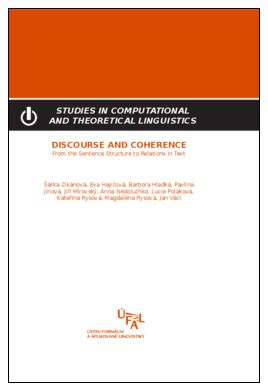Zikánová Šárka et al.: Discourse and Coherence.
From the Sentence Structure to Relations in Text
|
|
Abstract:What is the nature of text? Are there general rules for the structure of text (discourse)? If so, what are the mechanisms that enable us to perceive a text as an integrated, coherent whole and how do they interact? Halliday and Hasan (1976) in their classical and detailed analysis of cohesion and coherence distinguish five such aspects that together organize a text as “a neatly woven texture”: conjunctions, reference, substitution, ellipsis and lexical cohesion. There are, of course, many other points of view that can be applied in discourse analysis, be it the intentional structure of a discourse, speech act analysis, the so-called pragmatic discourse relations, the subjectivity of discourse, etc., to name just a few. This research monograph, a fruit of eight years’ work by ten authors from the Institute of Formal and Applied Linguistics, gathers the findings on several different aspects of discourse coherence: discourse relations and discourse connectives, coreference, bridging relations (associative anaphora), information structure (topic–focus articulation) and salience of the elements of the stock of shared knowledge of the speaker and the hearer. The authors offer a comprehensive exploration of each of these aspects based on large-scale corpus evidence and concentrate on their interplay in establishing discourse coherence. The research is carried out under the Prague framework of Functional Generative Description and uses the main language resource stemming from this approach: the Prague Dependency Treebank 3.0 but it also partly adopts the Penn Discourse Treebank-style of shallow discourse analysis. The main research questions concern the following topics: (i) Since the building stone of discourse is a sentence, the authors study in which respects the sentence structure itself contributes to discourse structure; the analysis is based on the deep syntactic structure of the sentence. Special attention is paid to the information structure of the sentence (its topic–focus articulation) which is supposed to be an integral part of the deep syntactic structure. Also, the analysis of information structure is applied together with the analysis of coreference links in order to follow the development of discourse in terms of the salience of the elements of the stock of knowledge assumed by the speaker to be shared by him and the hearer. (ii) One distinctive feature of the used methodology is the fact that the discourse relations are built on top of the deep (underlying) dependency structure of sentences rather than on the raw text, which makes it possible to follow in which respects a representation of this structure can help us to identify discourse relations and their scope. (iii) Moving from the constituting elements of the discourse to the relations that combine these elements into larger wholes, or, more specifically, that exist between elementary parts of discourse, the so-called discourse relations are analyzed and classified, and the linguistic means identifying them are searched for; these means include connectives or their alternative complex expressions. (iv) An invaluable contribution to the connectivity of discourse is played by the connective threads carried out via coreference links and other associative relations. |





